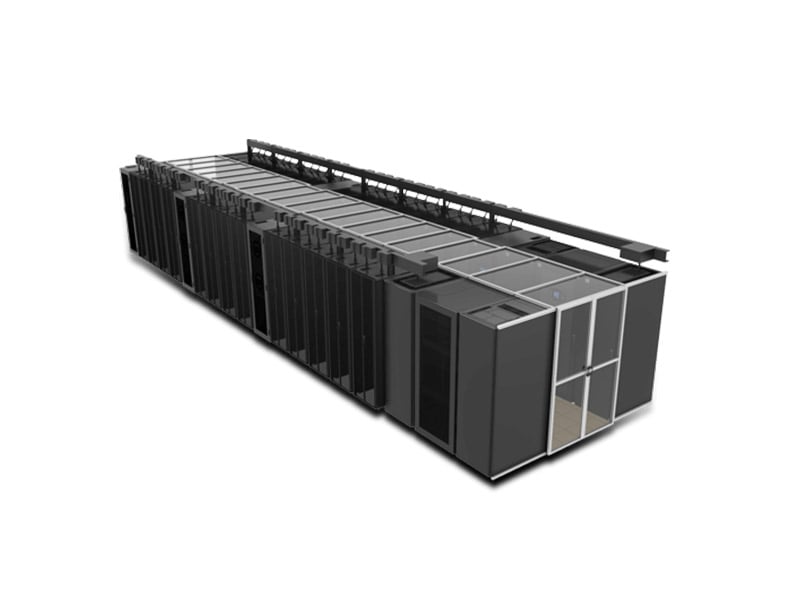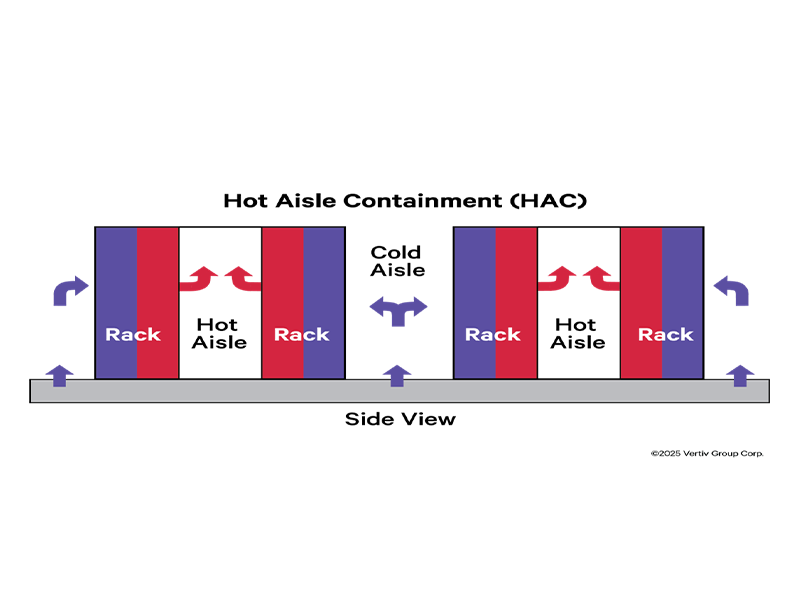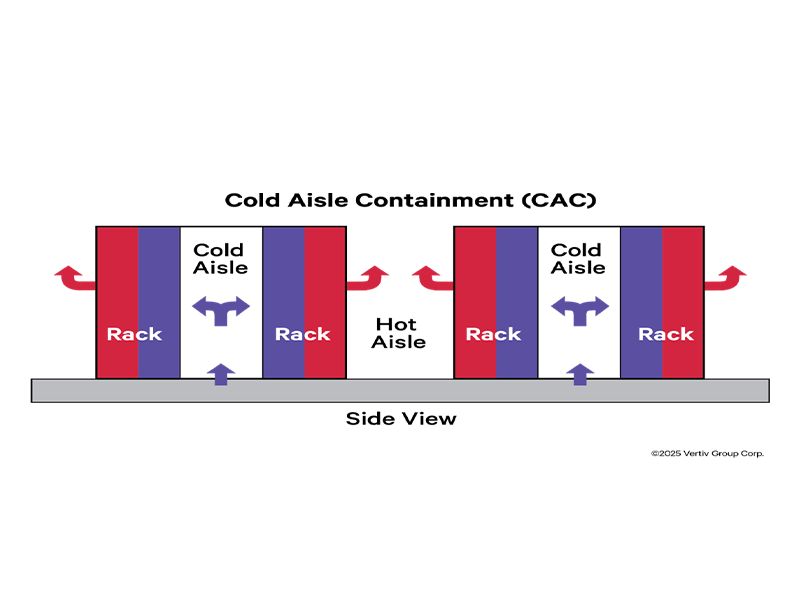With rack densities and heat loads reaching new highs, data center operators are looking to improve cooling efficiency solutions beyond choosing specific unit selections. Flexible configurations and overall facility plans should align with room layouts, airflow paths, business goals, and expansion plans.
Data center containment is a strategy that uses physical barriers, such as doors, ceiling panels, or curtains, to isolate hot and cold air streams within the IT environment to prevent mixing. Depending on the containment solution and strategy adapted to the environment, airflow is directed either toward IT equipment intakes or confined for controlled return to cooling units, facilitating energy efficiency.
Containment strategies—by separating hot and cold air—involve controlling airflow. By minimizing bypass airflow, the mix of hot and cold air at random, and recirculation, the IT room can support higher rack densities, support more consistent inlet temperatures, and enable equipment resilience.
Why data center containment matters
Containment stabilizes airflow across mixed deployments, limits heat spillover from liquid-cooled racks, and supports consistent inlet temperatures. While liquid cooling is critical for managing extreme rack densities, hot aisle containment (HAC) systems capture and isolate hot exhaust air, and cold aisle containment (CAC) systems enclose and direct cold supply air. Both approaches remain essential since most high-density environments still mix in air-cooled or hybrid rows.

Fig 1. Vertiv™ SmartAisle™ is a containment solution that integrates racks, cooling, power, and monitoring to optimize airflow, reduce energy use, and improve data center efficiency.
Data center containment directs airflow through thermal zones and rack layouts, keeping temperatures stable as density and compute loads rise. Planning for containment strategies early improves cooling performance, lowers energy use, and optimizes infrastructure can scale efficiently with growing operational demands.
- Cooling demands are rising: The Uptime Institute Global Data Center Survey 2025 shows that one in eight data centers now deploy racks at 30-59 kW, with some exceeding 100 kW. These densities are increasingly common in new builds and retrofits, driven by AI workloads and accelerated compute. As thermal loads climb, operators need cooling strategies that scale with demand without compromising efficiency or layout flexibility.
- Power is a fixed source: With the data center power usage projected to double by 2030, governments and utilities are no longer giving additional power allocations, requiring data centers to operate within defined energy thresholds. Containment strategies reduce the energy needed for cooling, allowing for power to be reallocated to more crucial functions such as compute workloads, and can expand economizer hours.
- Environmental standards are shaping cooling management expectations: Efficiency requirements are evolving worldwide, and operators need practical ways to work within their energy allocations. Containment strategies directly impact the power consumption of data center facilities, as—along with other methods and techniques—the operational and cost savings can be reallocated to other facility requirements.
Containment in high-density and liquid cooling environments
Containment techniques are not limited to traditional air cooling. In high-density deployments that use rear-door heat exchangers (RDHX) or direct-to-chip (DtC) loops, these can help stabilize room temperatures by separating hot and cold zones. This allows liquid cooling systems to operate without interference from recirculated air and helps maintain consistent conditions across the space.
In hybrid cooling setups, containment limits residual heat from liquid-cooled racks to the immediate zone, reducing the air-side load and keeping mixed environments stable. By estimated averages, a high-density ready design should be able to support:
- 20–30 kW per rack in air-cooled rows
- 35–50 kW with RDHXs, and
- Up to 100–130 kW in liquid or hybrid AI deployments
Precision airflow management is central to this, preventing bypass and delivering conditioned air directly to the load.
Hot aisle and cold aisle containment solutions
• Hot aisle containment (HAC): This design uses enclosed spaces around server exhaust areas to channel hot air directly to cooling systems through physical barriers (e.g., doors and ceiling panels). This isolation prevents hot air recirculation, particularly effective for dense server racks generating substantial heat.

Fig 2. Hot aisles are enclosed to capture server exhaust, while cool air enters from the raised floor into server fronts. The hot air is routed to return ducts or overhead cooling to improve efficiency. Arrows mark airflow paths.
• Cold aisle containment (CAC): This design encloses server intake areas using side panels and overhead barriers to concentrate chilled airflow. It integrates seamlessly with raised-floor environments, pairing with underfloor air distribution to deliver cooling precisely. CAC more effectively separates hot and cold air streams, focusing on directing supply air to server intakes, and is considered beneficial in raised-floor retrofits.

Fig 3. Cold aisles are enclosed to direct cool air into server fronts, while hot exhaust is released into the hot aisle and routed away to improve efficiency. Arrows mark airflow paths.
Operational strategies for high-density data center containment
Hybrid systems blend HAC, CAC, and vertical exhaust ducting for adaptable airflow management. They’re ideal for hyperscale or colocation data centers with shifting workloads and layouts. Hybrid systems balance flexibility and cooling efficiency by combining row-based air, rear-door heat exchangers, and direct-to-chip loops to segregate heat and maintain stable inlet temperatures.
Matching the strategy to the required workloads
HAC excels in high-density environments with heat-intensive workloads and environments like artificial intelligence (AI) and machine learning, where its hot air isolation significantly improves cooling efficiency. CAC's targeted approach prevents hotspots and optimizes cooling performance, making it ideal for the following applications:
- Modern data centers with variable rack densities
- Raised-floor retrofits, or
- Environments requiring precise temperature control.
The choice between systems depends primarily on rack density, existing cooling infrastructure, and facility layout constraints.
Containment that keeps up
As cooling demand for increased compute density climbs, containment increasingly becomes a core design choice. It directly affects operating costs, energy efficiency, and infrastructure scalability. Vertiv designs containment strategies tailored for your site layout, rack density targets, and energy priorities. Get in touch with the Vertiv team today.







